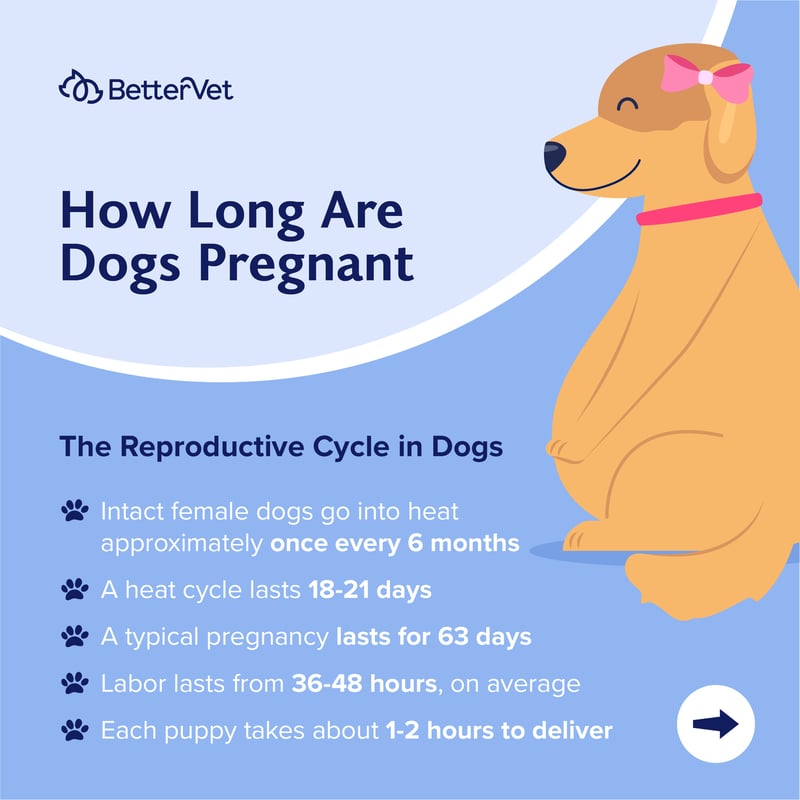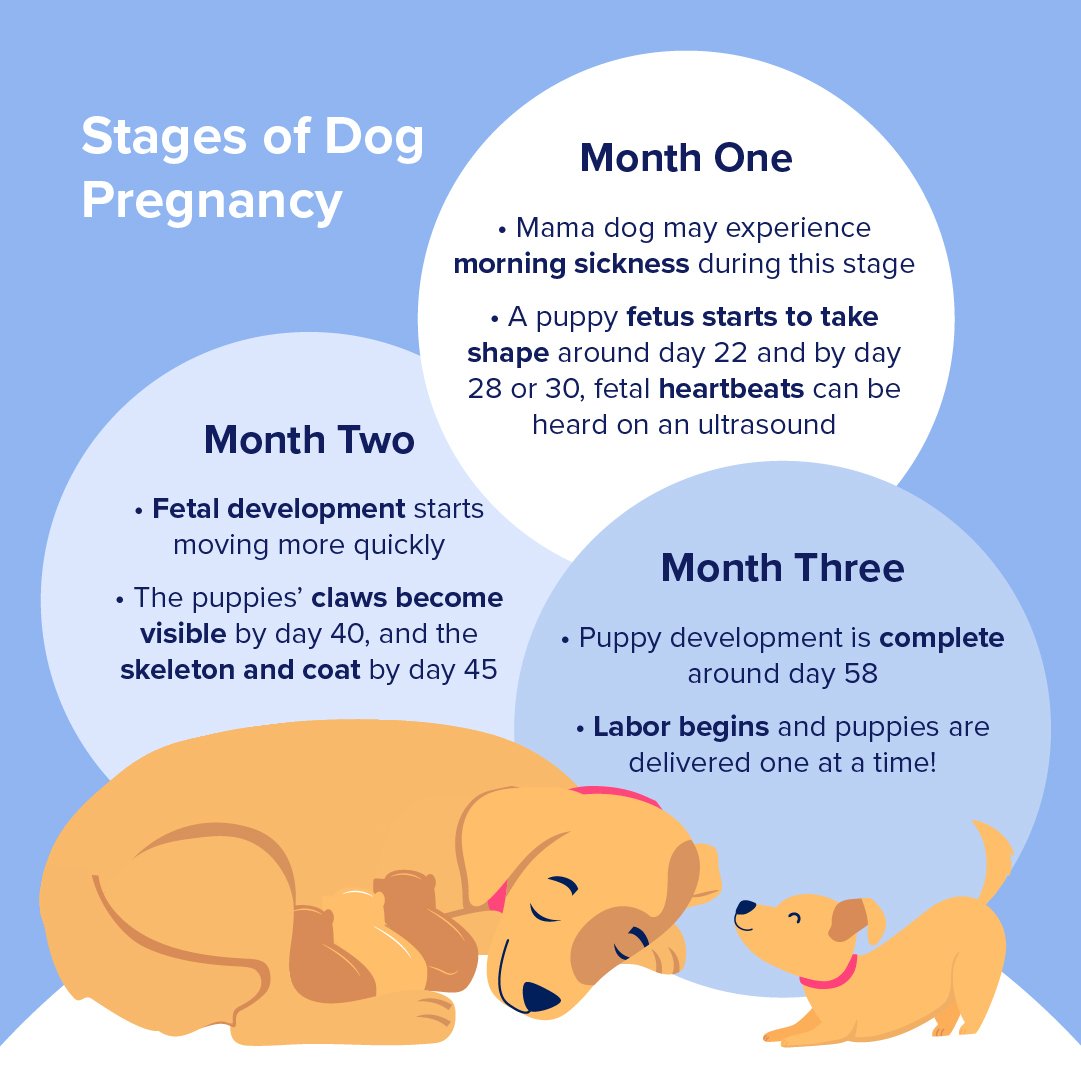How Long Are Dogs Pregnant?

Table of Contents
Understanding the reproductive cycle of dogs is essential for responsible pet care. We'll explore the duration of dog pregnancy, stages of pregnancy, signs of pregnancy, and important considerations for your dog's health during this crucial period. Whether you're a first-time or experienced pet owner, we're here to provide accurate information backed by years of veterinary expertise.
So let's dive in and explore the fascinating world of dog pregnancy together.
Key Takeaways:
- Dog pregnancy typically lasts around 63 days, varying among individual dogs.
- Pregnancy can be diagnosed through physical examination, blood tests, X-rays, and ultrasounds.
- Seeking veterinary guidance is vital for a healthy dog pregnancy. A vet can diagnose pregnancy, provide proper care, address health concerns, and ensure the well-being of the mother and puppies.
How Long Are Dogs Pregnant?
The duration of dog pregnancy is typically around 63 days, although it can vary slightly. The reproductive cycle of intact female dogs involves going into heat approximately once every 6 months, with each heat cycle lasting about 18-21 days. During pregnancy, the developing puppies undergo significant growth and development.
When it's time for labor, it generally lasts between 36 to 48 hours on average. Each puppy is typically delivered within 1-2 hours, but this can vary depending on various factors, such as the size and breed of the dog.
It's important to note that these timelines are general guidelines and may vary among individual dogs.

Stages of the Canine Reproductive Cycle
Intact female dogs experience a hormonal cycle starting around six months of age. They go through stages such as proestrus, estrus, diestrus, and anestrus. Here is a list of the stages explained:
- Proestrus: The start of the heat cycle marked by vulva swelling and bloody discharge, lasting a few days to three weeks. Mating is not allowed during this phase.
- Estrus: Receptive to breeding, this phase lasts three to 21 days. Ovulation occurs, even if not bred. The vulva softens, discharge may change color, and behavioral changes attract male dogs. Vaginal cytology can assist in determining breeding readiness.
- Diestrus: The female becomes uninterested in mating, vulva decreases in size. If not pregnant, diestrus lasts around two months.
- Anestrus: This is the non-breeding phase of the cycle and usually lasts four to five months.
Unlike humans, dogs do not have menstruation (the bloody discharge comes directly from the wall of the vagina) or menopause. However, their cycles may become more prolonged and more irregular with age. Keeping track of your dog's cycles is essential for their overall health.
Signs & Symptoms of Pregnancy in Dogs
Discovering whether your dog is pregnant can be an exciting and essential moment for dog owners. Here are some key indicators that can help you identify if your dog is pregnant:
- Vomiting: Some pregnant dogs experience occasional vomiting, similar to morning sickness in humans in the early stages.
- Lethargy: Pregnant dogs have increased fatigue and decreased activity levels in the early stages. They prefer resting over vigorous activities.
- Change in Appetite: Pregnant dogs may have an increased or decreased appetite, varying from dog to dog in the early stages.
- Physical Changes: As pregnancy progresses, your dog's body undergoes visible changes like weight gain and enlarged darker mammary glands.
- Nesting Behavior: Dogs in late pregnancy show nesting behavior, such as arranging to bed and searching for a comfortable birthing spot.
- Drop in Rectal Temperature: Your dog's rectal temperature noticeably drops before labor, indicating labor is approaching.
- Restlessness and Refusal of Food: As labor nears, dogs become restless and show a decreased appetite, which is typical preparation for labor.
As non-pregnant females can also display some of these signs, it is best to see your vet if you suspect your dog may be pregnant.
Should My Pet Be Seen by a Veterinarian?
1. Have you noticed changes in your pet’s appetite?
2. Does your pet have diarrhea or loose stools?
3. Have you noticed changes in your pet’s thirst/water consumption?
4. Is your pet having accidents in the house?
5. Is your pet pacing and unable to settle?
6. Is your pet panting more than usual?
7. Is your pet whining or vocalizing more than usual?
8. Is your pet shaking more than usual?
9. Is your pet hiding or avoiding physical contact more than usual?
10. Is your pet more lethargic and sleeping more than usual?
11. Are you concerned about changes in your pet’s behavior?
12. Is your pet scratching their ears?
13. Is your pet licking their paws more than usual?
14. Does your pet have a rash?
15. Is your pet moving more slowly than usual or having a harder time getting up or down?
View Results
Should My Pet Be Seen by a Veterinarian?
1. Have you noticed changes in your pet’s appetite?
2. Does your pet have diarrhea or loose stools?
3. Have you noticed changes in your pet’s thirst/water consumption?
4. Is your pet having accidents in the house?
5. Is your pet pacing and unable to settle?
6. Is your pet panting more than usual?
7. Is your pet whining or vocalizing more than usual?
8. Is your pet shaking more than usual?
9. Is your pet hiding or avoiding physical contact more than usual?
10. Is your pet more lethargic and sleeping more than usual?
11. Are you concerned about changes in your pet’s behavior?
12. Is your pet scratching their ears?
13. Is your pet licking their paws more than usual?
14. Does your pet have a rash?
15. Is your pet moving more slowly than usual or having a harder time getting up or down?
Share Quiz
How Are Dog Pregnancies Diagnosed?
Your vet can diagnose pregnancy in several ways, such as physical exams, bloodwork, x-rays, and ultrasounds. Here is a description of how each method is utilized:
-
Physical exam - As pregnancy progresses, your vet will be able to observe physical changes, including weight gain and mammary development. After 21 days, they may also be able to diagnose pregnancy by feeling fluid-filled sacs in the uterus on abdominal palpation.
-
Bloodwork - A blood test to measure the hormone relaxin produced by the placenta may be used after approximately 30 days.
-
X-rays - After 5 to 55 days, fetal skeletons will be visible on radiographs. This is also an excellent way to determine the number of puppies expected.
-
Ultrasound - After 25 to 35 days, ultrasounds can be used to diagnose pregnancy. It can also be used later in pregnancy to assess fetal health and heart rate.
Health Concerns During and After Pregnancy
Taking care of your dog's health during and after pregnancy is essential. Here are important considerations to ensure a healthy journey:
- Nutrition: Provide a high-quality, balanced diet for your pregnant and nursing dog. Feed small frequent meals to meet their increased energy requirements. Follow your vet's advice to prevent weight issues and support optimal health.
- Wellness care: Before pregnancy, ensure your dog is up to date on vaccines and parasite prevention. This helps pass immunity to her puppies. If the pregnancy is unplanned, consult your vet for appropriate wellness care options.
- Dystocia: Abnormal labor requires immediate veterinary evaluation. Some cases can be managed medically, but a c-section may be necessary for safety. Discuss a birth plan with your vet, recognize signs of dystocia, and keep emergency clinic contact information handy. Note that certain breeds may require c-sections.
- Eclampsia: A sudden drop in calcium levels can occur and must be promptly treated by a veterinarian.
- Inflammation or infection: Postpartum, the uterus, and mammary glands may become inflamed or infected. Contact your veterinary team if you suspect mastitis, metritis or if your dog appears unwell or has a fever.
Spaying Your Dog
Dog spaying involves surgically removing the uterus and ovaries to prevent possible pregnancy. If you are not planning on breeding your dog, getting her spayed is highly recommended for her health and well-being. Not only do you get to avoid dealing with messy heat cycles and unwanted litters contributing to overpopulation, but spaying a female dog can help her live longer, reduce the risk of diseases such as mammary cancer, pseudopregnancy, and pyometra (infection of the uterus), and improve behavior.
Conclusion
Understanding the reproductive cycle and signs of pregnancy in dogs is crucial for responsible pet care. By being aware of the stages of pregnancy and the health considerations during this period, you can ensure the well-being of both the mother and the puppies. Seeking veterinary guidance is essential for accurate diagnosis, proper care, and addressing potential health concerns.
Schedule regular check-ups with a veterinarian to provide the best care for your pregnant dog. They can confirm the pregnancy, provide guidance on nutrition and wellness care, and address any issues. Your vet will ensure a healthy journey for your dog and her puppies.
Frequently Asked Questions
Are there pregnancy tests for dogs?
You can’t purchase a home pregnancy test for your dog, but your vet has several ways of determining if she is pregnant. Depending on how early in the pregnancy, they may be able to tell if she’s expecting based on a physical exam, blood test, x-rays, or ultrasound.
How often can dogs get pregnant?
Dogs can get pregnant every time they come into estrus, which usually happens twice a year.
How do I prevent unwanted pregnancy?
Spaying your dog is the best way to prevent unwanted pregnancy, and it also benefits her health and well-being. Keeping intact male and female dogs (even siblings) separate during estrus is also critical. Medications are not commonly used in the United States and have the risk of side effects.







